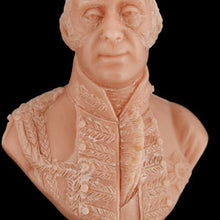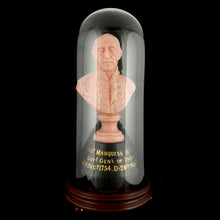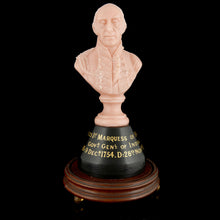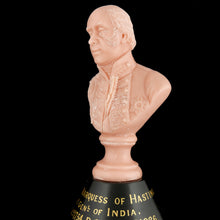Bust of Francis, 1st Marquess of Hastings, 1830
- Regular price
- £1,400
- Sale price
- £1,400
- Regular price
-
- Unit price
- /per
Adding product to your cart
Overall height: 22.5cm (8.9in)
Provenance:
Philip Davies Cooke, FLS, FGS, FZS, FHS, JP (1793-1853), of Gwysaney Hall, Flintshire, High Sheriff of Flintshire (1824).
Philip Bryan Davies-Cooke, FSA, DL, JP (1832-1903), of Gwysaney Hall, Flintshire, and Owston Hall, Yorkshire.
Thence by family descent.
Wax bust modelled as Frances, 1st Marquess of Hastings (1754-1836), Governor General of India, Raised on a conical ebonised base inscribed in gilt lettering. Covered with associated glass dome on stand, 29.5cm high overall.
Francis Edward Rawdon-Hastings, 1st Marquess of Hastings (1754-1826) entered the Army in 1771 and saw service in the American War of Independence (1775-1783), distinguishing himself at Bunker Hill (1775), where he received two bullets through his hat. In 1778 Rawdon was promoted Lieutenant-Colonel and was nominated Adjutant-General to the forces in America. In 1781 he attacked and defeated an American force at Hobkirk's Hill, a victory which Cornwallis described as 'by far the most splendid of this war’. Created Baron Rawdon of Rawdon, Yorkshire, in 1783, he took the extra surname of Hastings in 1790, in pursuance of his uncle's will. In 1793 Rawdon-Hastings succeeded his father as the 2nd Earl of Moira. After further service during the French Revolutionary and Napoleonic Wars, he was appointed Governor General of Bengal and Commander-in-Chief of the forces in India in 1812. In recognition of his conduct of the Gurkha War (1814-1816), he was created Marquess of Hastings in 1815. This success, and his victories over the Pindaris and Marathas (1817-1818) led to him being hailed as the man who completed Richard, Marquess of Wellesley's work of conquest in India. From 1824 until his death in 1826, Hastings served as Governor and Commander-in-Chief of Malta. Tall and imposing this portrait bust shows, Hastings was an able administrator who lived grandly. He left the strange instruction that his right hand should be cut off after death and preserved until the death of his wife, Flora, when it was to be placed in her coffin.










